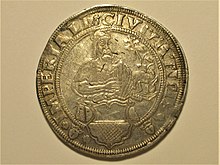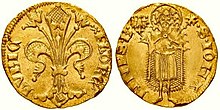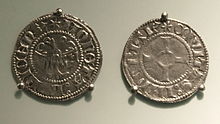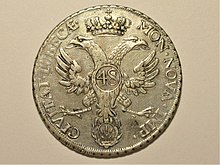Lübeck coin history
The history of coins in Lübeck goes back to the 12th century; coins for the Hanseatic city of Lübeck were minted in 1159 at the earliest. Minting in Lübeck ended in 1801. Between 1901 and 1912, the last coins were minted in the name of the Hanseatic city of Lübeck in Berlin . The coins of the Diocese of Lübeck , however, do not belong to the coin history of the city of Lübeck.
The high medieval beginnings
Heinrich the Lion began as lord of the city in 1159 at the earliest with the minting of denarii , which were minted on both sides, for the new city of Lübeck, which was supposed to open up trade in the Baltic Sea for Heinrich .
With the award of the coin shelf , initially only for silver coins, in 1226, the minting of own coins began, i.e. not those of a city lord. Initially, the bracteates were stamped on one side and weighed less than the previous denarius. In 1255 Hamburg and Lübeck agreed a uniform weight for their bracteates of 0.5 g. In the period that followed, these pennies not only lost weight; they were also pronounced with a lower proportion of fine silver. This fine silver content fell by 40 percent in the following years.
After the coin shelf was expanded to include gold coins, Lübeck began minting (gold) guilders in 1341 under the mint owner Tidemann von Güstrow , which was not used in inner-city payments, but to a limited extent as long-distance trade coins .
The Wendish Mint Association
In 1356 at the earliest, Lübeck minted a silver 4-pfennig piece, the Witten , with an initial total weight of 1.33 g, which, with a fine silver content of 875 ⁄ 1000 , corresponded to a fine silver weight of 1.16 g. About 15 million pieces are said to have been minted in Lübeck in the ten years after 1367.
This denomination was imitated by other cities, so that the need arose to reliably standardize the value of these coins. With the recess of 1379 the Wendische Münzverein was created , to which Hamburg and Wismar belonged in addition to Lübeck . Lüneburg also joined in 1381 . Other Hanseatic cities (especially Rostock , Stralsund ) and Mecklenburg later also minted according to the rules of the Wendish Mint Association.
Since 1388 and finally after the recession of 1422, the three and six pfennig coins, triples and sextuplets , replaced the witten. Since 1433 these two denominations were supplemented by the shilling , which was worth 12 pfennigs. In the years that followed, the shilling increasingly became the main coin, even though triplets and sextuplets continued to be minted into the 18th century. The double schilling followed later as a further denomination. The fine silver content of all denominations has meanwhile been steadily reduced. For example, according to agreements with Hamburg, the first Lübeck double schillings contained 0.8125 fine silver, but as early as 1468 the two cities agreed to lower the fineness to 0.750.
At the end of the 15th century, the gold gulden was equated to a value of 32 shillings. Later, a large silver coin was minted with a value and face designation of 32 shillings, which was to become the most important large silver coin by the 18th century.
The state mark
Mark was originally the name for a medieval unit of weight for precious metals of about half a Carolingian pound. The well-known Cologne weight mark was just under 234 g and served as a basic unit for various European coin feet, u. a. the official monetary standard of the Holy Roman Empire .
In 1502, the mark worth a Rhenish silver guild was first minted as a coin. From 1507 the whole mark was minted as a face. The mark was called "Statvs Marce Lvbice" and was called the state mark. Since 16 shillings are equal to one mark, 32 shillings are two marks. The coins in this series, down to the dreiling, were all minted in silver or billon .
The minting of copper shears worth half pfennigs was an exception (1542 to 1570).
The thaler

The wide acceptance of the beginning of the 16th century for the first time pronounced thaler also prompted Lübeck under Mayor Nicholas Brömse , this new large silver nominal 1537 to produce the first time. An overall system settled in, according to which the guilder received the value of 2 ⁄ 3 thalers. The guilder was still 32 shillings (equal to 2 marks) and the thaler 48 shillings (equal to 3 marks). This basic system remained until the end of Lübeck silver coinage in the 18th century .

Shillings
Within the coin system based on the taler and the mark, the majority of the coins were minted as late shillings. The denominations, which corresponded to a whole mark or a whole thaler, usually had a value in shillings alone.
The nominal structure of the minted Lübeck coins in the 18th century was as follows:
- 48 shillings (= 3 marks) = 1 thaler = 576 pfennigs
- 32 shillings (= 2 marks) = 1 species rich thaler = 384 pfennigs
- 16 shillings (= 1 mark) = ½ species rich thaler = 192 pfennigs
- 8 shillings (= ½ Mark) = 1 ⁄ 4 species rich thalers = 96 pfennigs
- 4 shillings (= 1 ⁄ 4 marks) = 1 ⁄ 8 species thaler = 48 pfennigs
- 1 ⁄ 24 Reichstaler (= 1 Groschen) = 24 pfennigs
- 2 shillings (= 1 ⁄ 8 marks) = 1 ⁄ 16 species rich thalers = 24 pfennigs
- 1 schilling (= 1 ⁄ 16 marks) = 1 ⁄ 32 species rich thaler = 12 pfennigs
- 1 sextuplet (= ½ Schilling) = 1 ⁄ 64 Speciesreichstaler = 6 Pfennigs
- 1 Dreiling (= 1 ⁄ 4 Schilling) = 1 ⁄ 128 Speciesreichstaler = 3 Pfennigs
- 1 ⁄ 192 thalers (= 1 dreiling) = 3 pfennigs
The 1 ⁄ 24 Reichstaler and the 1 ⁄ 192 thaler are fragments of the 48 schillingen thaler, not the 32 schillingen species thaler. The Dreischillingstück ( Dütchen ) was no longer minted in Lübeck in the 18th century. The minting of double ducats, ducats, half ducats and quarter ducats made of gold cannot be brought into a fixed arithmetical value ratio to the aforementioned silver and billon coins ( bimetallism ). The pfennig or its half-piece, the Scherf , were no longer minted in the 18th century. After the attempt in the 16th century with the copper knife, copper coin production was not resumed in the 18th century, despite opposing tendencies in many other regions of Germany.
In the 18th century, Lübeck followed the example of Hamburg and introduced a mark in the 34-mark coin base. However, coins denominated in Schilling Hamburger Current were not minted in Hamburg . The French name Courant for shilling and counting marks was later established in the Hanseatic cities and the neighboring principalities .
The end of Lübeck coinage
The Hamburg-Lübeck schilling system was one of the seven currency systems that still existed when a common imperial currency was introduced after the establishment of the empire in 1871. While Hamburg occasionally minted 32 shilling pieces and small coins worth 1 shilling and sextuplets and triplets in the 19th century , the silver coinage of the Lübeck coin in Fleischhauerstraße 18 ended in 1797. The Lübeck schilling denominations and the sextuplets and triplets from the 18th century . In the 19th century, until the introduction of the imperial coins, more and more foreign coins were still in circulation.

The last gold coin, a ducat , was minted in Lübeck in 1801. For exactly 100 years, coins were not minted for Lübeck either in Lübeck or in other mints. Between 1901 and 1912, 2, 3 and 5-mark silver coins as well as 10-mark gold coins of the imperial currency were minted. The back of these denominations were allowed to design the member states of the German Reich with the portrait of their prince or in the case of the city states with their coat of arms (Art. 3, § 2 of the Reich Coin Act of July 9, 1873). However, the member states no longer had any influence on the actual parameters of the coin policy.
Lübeck minters and mint masters
- Statius Wessel (II), mint master 1603–1616
- Adolf Mattheus Rodde , mint owner 1716–1729
See also
literature
- Dieter Dummler : The coin collection of the imperial and Hanseatic city of Lübeck. (= Trade, money and politics. Issue 12). Lübeck 2012, ISBN 978-3-7950-4511-1 .
- Dieter Dummler: Seven Hundred Years of Money in Lübeck. Published by the Archives of the Hanseatic City of Lübeck, Issue 24, Lübeck: Schmidt-Römhild 2015 ISBN 978-3-7950-3123-7 .
- Heinrich Behrens : The coins and medals of the city and the diocese of Lübeck. Lübeck 1905.
- Wilhelm Jesse : The Wendish Mint Association. Reprint with supplements and improvements, Braunschweig 1967, DNB 457098694 .
- Herbert Rittmann : About the historical development of the city of Lübeck and its monetary significance. In: Monetary History News . November 1971, pp. 358-360.
- Gerhard Schön : German coin catalog 18th century. 3. Edition. Battenberg Verlag, Munich 2002, ISBN 3-89441-525-8 , pp. 519-522.
- Wolfgang Trapp : Small handbook of coinage and the monetary system in Germany. Reclam-Verlag, Stuttgart 1999, ISBN 3-15-018026-0 .
Web links
Individual evidence
- ↑ Dieter Dummler: The coin collection of the imperial and Hanseatic city of Lübeck. 2012, p. 10 f.
- ↑ Dieter Dummler: The coin collection of the imperial and Hanseatic city of Lübeck. 2012, pp. 11-14.
- ↑ Dieter Dummler: The coin collection of the imperial and Hanseatic city of Lübeck. 2012, pp. 16-18.
- ↑ Dieter Dummler: The coin collection of the imperial and Hanseatic city of Lübeck. 2012, pp. 19-20.
- ↑ Dieter Dummler: The coin collection of the imperial and Hanseatic city of Lübeck. 2012, pp. 18-19.
- ↑ Dieter Dummler: The coin collection of the imperial and Hanseatic city of Lübeck. 2012, pp. 20–21.
- ↑ Dieter Dummler: The coin collection of the imperial and Hanseatic city of Lübeck. 2012, p. 30.
- ↑ Dieter Dummler: The coin collection of the imperial and Hanseatic city of Lübeck. 2012, pp. 24–28.
- ↑ Dieter Dummler: The coin collection of the imperial and Hanseatic city of Lübeck. 2012, p. 32ff.
- ^ Heinrich Behrens: Coins and medals of the city and the diocese of Lübeck. 1905, pp. 185f.
- ↑ Dieter Dummler: The coin collection of the imperial and Hanseatic city of Lübeck. 2012, p. 38f.
- ^ Gerhard Schön: German coin catalog 18th century. 2002, pp. 519-522.
- ↑ Wolfgang Trapp: Small handbook of coinage and money in Germany. 1999, p. 102f.





